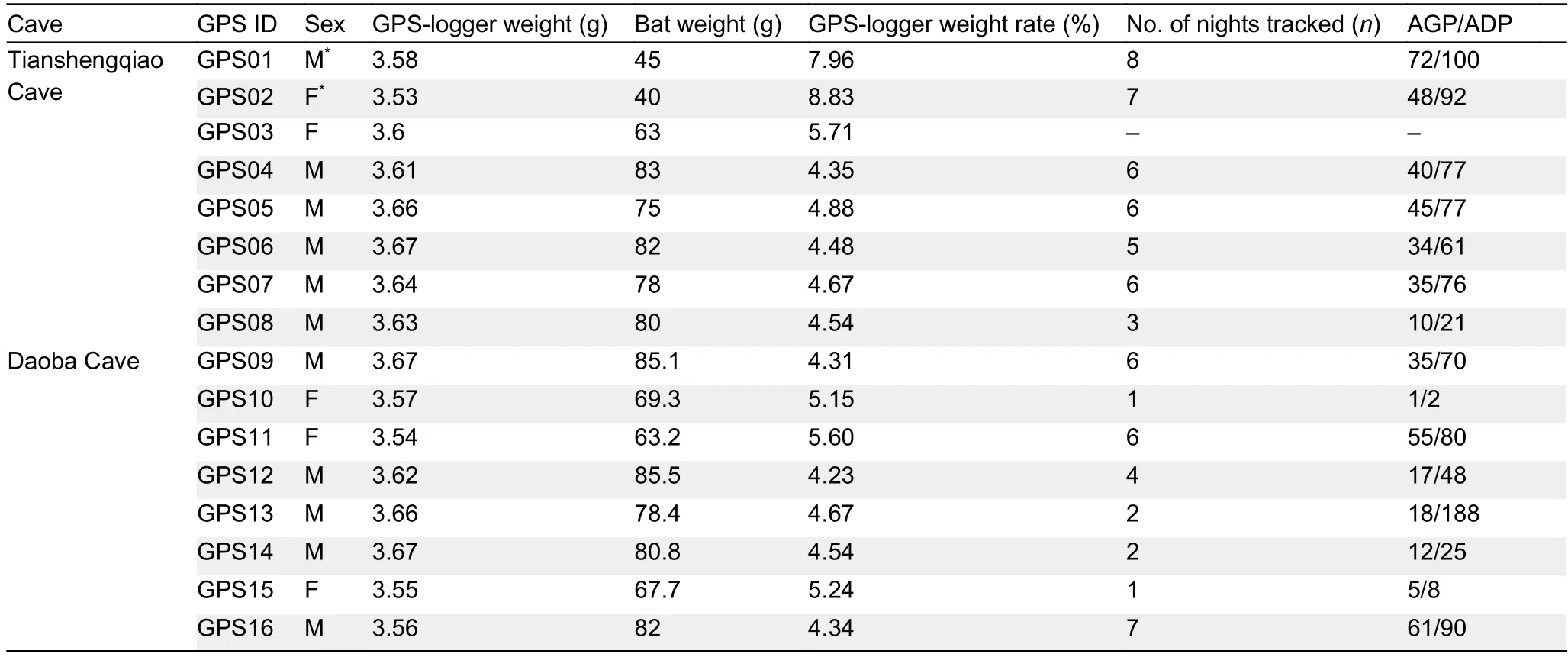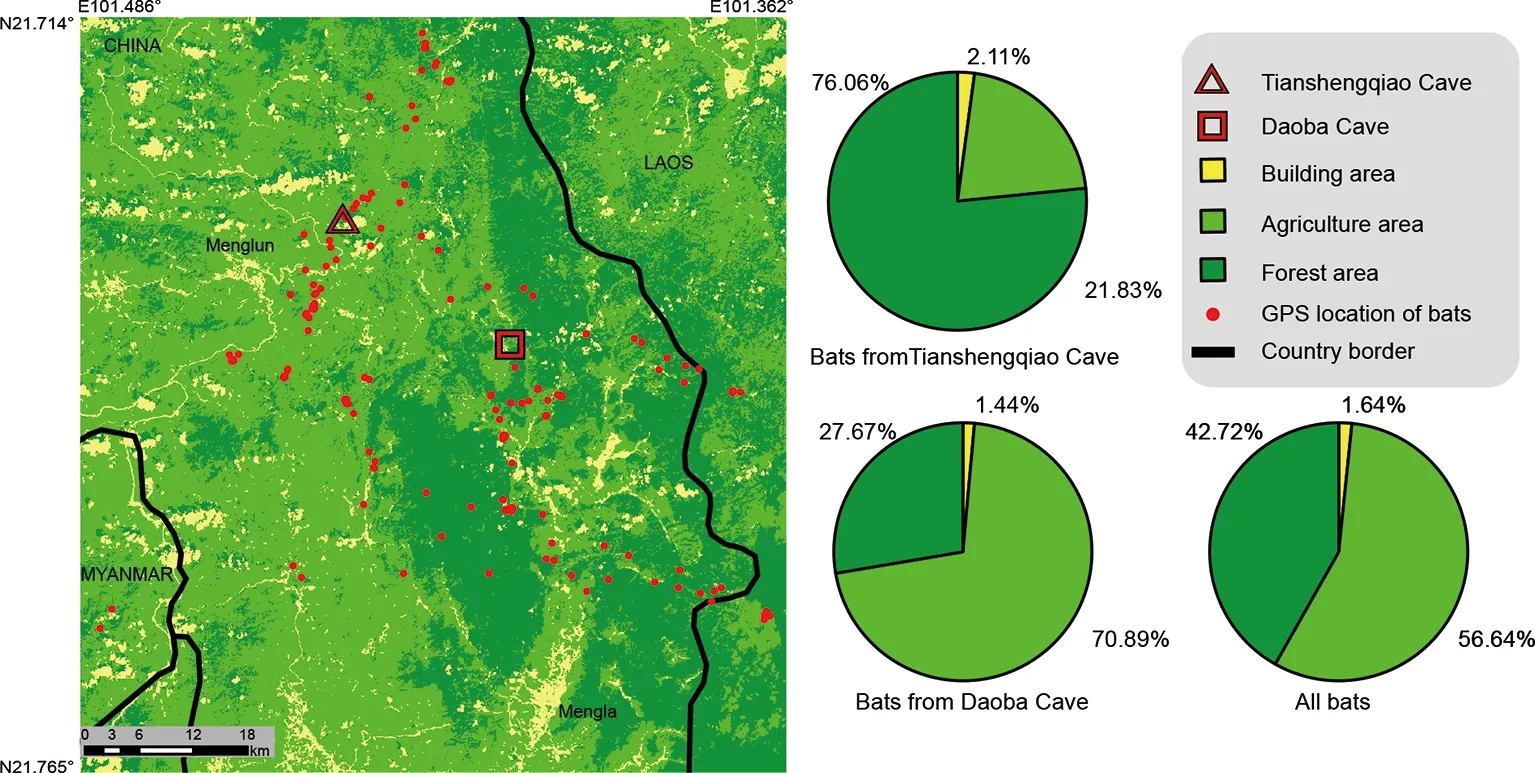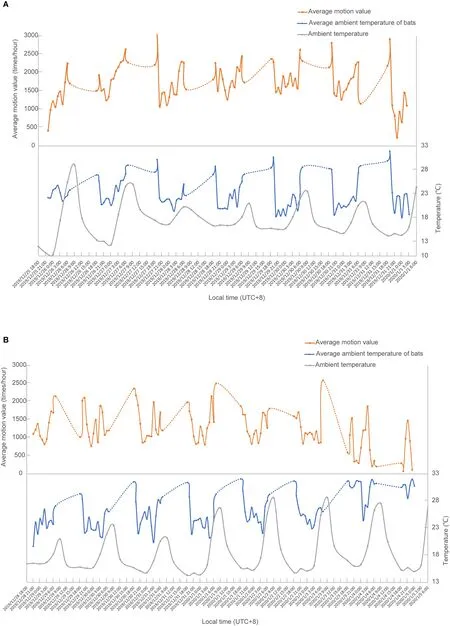Ecological study of cave nectar bats reveals low risk of direct transmission of bat viruses to humans
2022-08-05KaiZhaoWeiZhangBeiLiShiZheXieFanYiRenDiJiangYunLuoXiangYangHeYunZhiZhangZhengLiShiLiBiaoZhangXingLouYang
Kai Zhao ,Wei Zhang ,Bei Li ,Shi-Zhe Xie ,Fan Yi ,Ren-Di Jiang ,Yun Luo,Xiang-Yang He,Yun-Zhi Zhang,Zheng-Li Shi,Li-Biao Zhang,*,Xing-Lou Yang,*
1 CAS Key Laboratory of Special Pathogens and Biosafety, Wuhan Institute of Virology, Chinese Academy of Sciences, Wuhan, Hubei 430071, China
2 University of Chinese Academy of Sciences, Beijing 100049, China
3 Guangdong Key Laboratory of Animal Conservation and Resource Utilization, Guangdong Public Laboratory of Wild Animal Conservation and Utilization, Institute of Zoology, Guangdong Academy of Sciences, Guangzhou, Guangdong 510260, China
4 School of Public Health, Dali University, Dali, Yunnan 671003, China
ABSTRACT Bats are reservoirs of various viruses.The widely distributed cave nectar bat (Eonycteris spelaea) is known to carry both filoviruses and coronaviruses.However,the potential transmission of theses bat viruses to humans is not fully understood.In this study,we tracked 16 E.spelaea bats in Mengla County,Yunnan Province,China,using miniaturized GPS devices to investigate their movements and potential contact with humans.Furthermore,to determine the prevalence of coronavirus and filovirus infections,we screened for the nucleic acids of the Měnglà virus (MLAV) and two coronaviruses(GCCDC1-CoV and HKU9-CoV) in anal swab samples taken from bats and for antibodies against these viruses in human serum samples.None of the serum samples were found to contain antibodies against the bat viruses.The GPS tracking results showed that the bats did not fly during the daytime and rarely flew to residential areas.The foraging range of individual bats also varied,with a mean cumulative nightly flight distance of 25.50 km and flight speed of up to 57.4 km/h.Taken together,these results suggest that the risk of direct transmission of GCCDC1-CoV,HKU9-CoV,and MLAV from E.spelaea bats to humans is very low under natural conditions.
Keywords:Bats;Eonycteris spelaea;GPS tracking;GCCDC1-CoV;HKU9-CoV;Měnglà virus
INTRODUCTION
Many emerging infectious diseases (EIDs) that pose a threat to human health are zoonotic (Fauci &Morens,2012;Jones et al.,2008).Bats are recognized as the natural reservoir of various viruses,such as the Marburg,Nipah,and Hendra viruses (Amman et al.,2020;Chua et al.,2002;Halpin et al.,2000;Towner et al.,2009).The ancestors of severe acute respiratory syndrome coronavirus (SARS-CoV),SARS-CoV-2,and Middle East respiratory syndrome coronavirus (MERSCoV) are also thought to have originated in bats (Anthony et al.,2017;Ge et al.,2013;Hu et al.,2017;Temmam et al.,2022;Wacharapluesadee et al.,2021;Wong et al.,2020;Zhou et al.,2020b).With extensive surveillance and highthroughput nucleic acid sequencing,many novel bat viruses have been discovered;however,their potential transmission to humans is not yet fully understood (Chen et al.,2014;Tan et al.,2021).
The cave nectar bat (Eonycteris spelaea) is broadly distributed,with a geographical range from the Malay-Indonesian archipelago to southern China and South Asia(Francis et al.,2008).These bats are pollinators of many fruit trees and agricultural crops (Bumrungsri et al.,2013;Thavry et al.,2017) and can forage considerable distances (up to 38 km) from their roosting sites (Acharya et al.,2015).In China,E.spelaeabats are distributed in tropical regions,with the highest density found in Yunnan Province.Research has shown thatE.spelaeabats can carry various coronaviruses(GCCDC1 coronavirus,GCCDC1-CoV;HKU9 coronavirus,HKU9-CoV) and filoviruses (Měnglà virus,MLAV) (Huang et al.,2016;Latinne et al.,2020;Luo et al.,2018;Yang et al.,2017,2019).Both GCCDC1-CoV and HKU9-CoV belong toBetacoronavirusgenus,and GCCDC1-CoV is a cross-family recombinant coronavirus with the P10 gene derived from orthoreovirus (Huang et al.,2016).GCCDC1-CoV,HKU9-CoV,and MLAV are also found inRousettusandEonycterisbats (Luo et al.,2018;Yadav et al.,2020).MLAV belongs toDianlovirus,which is phylogenetically related to the Ebola and Marburg viruses of theFiloviridaefamily (Yang et al.,2019).
As bats primarily fly at night,studying their ecology can be extremely difficult.To overcome this limitation,solar-powered Global Positioning System (GPS) and very high frequency(VHF) tracking devices have been used to investigate the ecological traits of large arboreal fruit bats (Choden et al.,2019;Egert-Berg et al.,2018;Oleksy et al.,2017;Randhawa et al.,2020;Weller et al.,2016).For cave-dwelling bats,VHF and miniature non-rechargeable GPS devices have been used for tracking (Castle et al.,2015;Hurme et al.,2019),but are limited to medium-sized bats due to weight restrictions.Miniaturized GPS tracking devices based on the Global System for Mobile Communications (GSM) have also been developed for wild birds (Meng et al.,2020;Yu et al.,2017).
Risk assessment of viral infection has primarily focused on epidemiology (Dovih et al.,2019;Wang et al.,2018).We hypothesized that the ecological behavior of bats may also play a role in the transmission of viruses to humans.To test this hypothesis,we investigated the ecological behavior ofE.spelaeabats in Mengla County,Yunnan Province,China,using GPS-GSM tracking devices,combined with study of bat virus epidemiology and local resident serology.
MATERIALS AND METHODS
Ethics statement
This study and related scientific field surveys were approved by the Guangdong Entomological Institute Administrative Panel (Approval No.GDEI‐AE‐2 006 001) and the Yunnan Institute of Endemic Diseases Control and Prevention(Approval No.DLDXLL2013002).All animal and human sample collection protocols complied with the current laws of China.
Study sites
We investigated two colonies ofE.spelaeabats in two different caves (Daoba Cave,E101.51356º,N21.795097º,1 265 m above sea level (a.s.l.) and Tianshengqiao Cave,E101.374023º,N21.996787º,655 m a.s.l.) located 44.3 km apart in Mengla County,Yunnan,China (Figure 1).Mengla has a population of more than 297 900 people,with major revenue from tourism and farming of tropical crops such as tea,bananas,and rubber (https://www.ynml.gov.cn/index.dhtml).Both bat colonies are located close to residential and agricultural areas (Daoba Cave:0.5 km,Tianshengqiao Cave:2.7 km) and contain thousands of bats.The bats were captured with mist nets and temporarily restrained in a cotton bag.Only males and non-pregnant females were used(O'Mara et al.,2014;Sikes &The Animal Care and Use Committee of the American Society of Mammalogists,2016;Sikes and Bryan II,2016).

Figure 1 Flight map of 14 out of 16 bats tagged with GPS-loggers
GPS-logger attachment
The GPS tracking device (GPS-logger) used in this study was developed by GSM (GSM-GPS,HQZN,Hunan Global Messenger Co.,Ltd.,China).The GPS transmitted timestamped geolocation data to the receiver in the GPS-logger attached to each bat with a 92% accuracy within 10 m (Yu et al.,2017).The GPS-loggers collected positional data at preprogrammed intervals (between 1800h–0700h).The data,which included bat ID,date,time,longitude,latitude,speed,course,and altitude (Table 1),were then retrieved via the Short Message Service (SMS) of the GSM mobile phone network.All GPS-loggers were carefully inspected to ensure that they had no adverse effect on the bats.

Table 1 Summary of bat and GPS-logger data
Analyses of bat movement data
The GPS data were converted to Keyhole Markup Language(KML) files using the Tracker Client software,then imported into Google Earth Pro for display and analysis.Both the mean and range of cumulative distances flown each night and each hour by each bat were determined.The maximum straight-line distance between the caves and the most distant foraging site was also determined.Home ranges were estimated using the 100% (95%,90%) minimum convex polygon (MCP) method and 95% (90%,50%) fixed kernel density estimation (KDE)with a pre-defined reference bandwidth with the Home Range Tools (HRT) in ArcGIS® v10.2 (Baíllo &Chacón,2021).Meteorological satellite data (October 2020) of the study areas were obtained from the Geospatial Data Cloud(http://www.gscloud.cn/),analyzed using ENVI v5.3 software for land use types,and mapped with ArcMap software.Based on the meteorological satellite data of Mengla in October 2020,land use types were classified as residential,forest,or agricultural.Average activity and average body temperature per hour of the bat populations were also determined.
Bat anal sample collection
Anal samples,which are considered better than nasal,pharyngeal,and blood samples for coronavirus detection (Zhou et al.,2020a),were collected as described previously(Li et al.,2005).All bats were released to their roosting site after sampling.Bat species were identified based on morphological characteristics and confirmed by cytochromeb(cytb) gene sequencing (Luo et al.,2018).All samples were stored at −80 °C until use.
Viral detection
RNA was extracted from the anal samples using a High Pure Viral RNA Kit (Roche,Switzerland).For detection of coronavirus RNA,a portion of the RNA-dependent RNA polymerase (RdRp) gene was amplified using a SuperScript III OneStep RT-PCR and Platinum Taq Enzyme Kit (Invitrogen,USA) with family-specific degenerate semi-nested polymerase chain reaction (PCR),as described previously (Luo et al.,2018).Detection of filovirus RNA was performed following previous research (Yang et al.,2017).The PCR products were gel-purified and sequenced using the Sanger ABI-PRISM platform (Tsingke Biotechnology,China).
Serological tests
The GCCDC1-CoV nucleocapsid (N) protein (MG762691.1),HKU9-CoV N protein (MG762674.1),and MLAV N protein(KX371887.2) were expressed using the eukaryotic expression system in HEK293 cells (Supplementary Figure S1) (Li et al.,2019).The proteins were then used as antigens to develop in-house anti-viral immunoglobulin G (IgG)enzyme-linked immunosorbent assay (ELISA) kits.To perform ELISA,MaxiSorp Nunc-Immuno 96-well ELISA plates were coated (100 ng per well) overnight with a selected recombinant N protein.Human serum samples were collected by local clinics from 167 villagers who lived near the two study caves as previously study (Li et al.,2019).No personal identifying information was collected.The sera were used at a dilution of 1:20 and added to the wells for 1 h at 37 °C.Antihuman IgG horseradish peroxidase (HRP)-conjugated monoclonal secondary antibody (Kyab Biotech,China) was then used.The OD450values of wells were recorded to quantify antibodies against the selected viral N protein.For controls,we collected 96 serum samples from healthy participants in Wuhan,where the likelihood of people encountering bats is very low.The mean OD value of all negative serum samples plus three standard deviations was established as the cut-off value for positive serum (Li et al.,2019;Wang et al.,2018).
RESULTS
GPS-logger data
Sixteen cave nectar bats were tagged with GPS-loggers,including eight bats from Daoba Cave (five males and three females) and eight bats from Tianshengqiao Cave (six males and two females) (Figure 1;Table 1).The mean weight of the tagged GPS-loggers was less than 5.22% (3.61±0.05 g,min:3.53 g,max:3.67 g) of bat body weight (72.4±13.3 g,min:40 g (subadult female),max:85.5 g (adult male)).The longest working time of the GPS-loggers was eight nights (Table 1).Mean cumulative nocturnal flight distance was 25.76 km (min:0.09 km,max:132.18 km) for the Daoba Cave bats and 25.33 km (min:0.03 km,max:102.63 km) for the Tianshengqiao Cave bats (Table 2).Mean flight altitude was 1 000.19 m a.s.l.(min:488 m,max:1 833 m) for the Daoba Cave bats and 933.63 m a.s.l.(min:599 m,max:1 495 m) for the Tianshengqiao Cave bats (Table 2).Mean flying speed was 19.93 km/h (min:1.5 km/h,max:49.1 km/h) for the Daoba Cave bats and 19.84 km/h (min:1.5 km/h,max:57.4 km/h) for the Tianshengqiao Cave bats.The longest flight distance was recorded for a female Daoba Cave bat (GPS11),with a cumulative distance of 123.36 km in one night and 132.28 km the next night from its roost in Myanmar to a new roost in Laos(Table 2;Figure 1).One male Tianshengqiao Cave bat(GPS04) flew 89.9 km from Tianshengqiao Cave to its foraging ground in Laos every night for four consecutive nights and rested in Daoba Cave on its return on the fifth night(Table 2;Figure 1).
Spatial overlap of bat and human activities
Home ranges of individual bats varied from 0.06 and 2 905.13 km2based on 95% KDE and between 0.000 5 and 780.05 km2based on 100% MCP estimation (Table 2).Home ranges were 1 528.38 km2(95% KDE) and 1 556.26 km2(100% MCP) for the eight Daoba Cave bats and 2 297.69 km2(95% KDE) and 1 504.49 km2(100% MCP) for the eight Tianshengqiao Cave bats.The overlapping home range area between the Daoba Cave and Tianshengqiao Cave bats was 286.77 km2(95%KDE) and 359.79 km2(100% MCP) (Figures 2,3).The area around Daoba Cave was mainly forest,with the main activity areas being farmland (70.89%),forest (26.67%),and residential (1.44%) (Figure 3).The area around Tianshengqiao Cave was mainly farmland,with the main activity areas being forest (76.06%),farmland (21.83%),and residential (2.11%) (Figure 3).Overall,the main activity areas of all GPS-logger tagged bats in Mengla were farmland(56.64%),forest (42.72%),and residential (1.64%) (Figure 3).

Table 2 Bat flight distance and speed.
Time separation between bat and human activities
The first peak in activity (motion collected by GPS-loggers) of the Daoba Cave bats occurred from 1800h to 1930h,with second,third,and fourth peaks in activity occurring at about 0030h,0230h,and 0630h,respectively (Figure 4A).The first peak in activity of the Tianshengqiao Cave bats occurred from 1800h to 2030h,with second,third,and fourth peaks in activity occurring at about 2230h,0130h,and 0630h,respectively(Figure 4B).These results were positively correlated with average activity per hour and temperature around the bat bodies.During the daytime (0730h–1730h),the bats rested in the caves.The Daoba Cave bats left the cave about 15 min after sunset,while the Tianshengqiao Cave bats left the cave about 10 min after sunset.As human activity in the agricultural areas mainly occurred during the daytime,there was little overlap in time between human and bat activities.
Prevalence of viruses in E.spelaea
The anal swab samples of bats from the Daoba and Tianshengqiao caves were collected from January to December 2019 (Figure 1).Seventeen (12.8%) of the 133 samples were determined to be positive for GCCDC1-CoV or closely related viruses based on RT-PCR targeting the RdRp gene.The positive rates for GCCDC1-CoV varied with sampling time and site.GCCDC1-CoV was not detected in Daoba Cave bats in December but was relatively prevalent in June (5 of 39,12.8%) and January (9 of 30,30.0%).Three(10.3%) of the 30 Tianshengqiao Cave bats were positive for GCCDC1-CoV in December (Table 3).HKU9-CoV and MLAV were not detected in anyE.spelaeabats examined in this study (Table 3).

Table 3 Virus positive rates in E.spelaea bats

Figure 2 Simulation map of bat home range.Left:bat home range simulated by MCP

Figure 3 GPS localization of bats in different areas (left) and percentage of two bat colonies in different areas

Figure 4 Temporal pattern of bat activity
Seroprevalence of viruses in humans
A total of 167 human serum samples from three villages near Daoba Cave were collected and screened by ELISA using the N proteins of GCCDC1-CoV,HKU9-CoV,and MLAV as antigens,with the cutoff value determined based on healthy serum samples previously collected in Wuhan (Wang et al.,2018).Results showed that all serum samples were negative(Figure 5).

Figure 5 Serological test results of people residing near bat colonies
DISCUSSION
The incidence of EIDs has increased over the last 50 years(Jones et al.,2008).More than 70% of EIDs are of animal origin and bats are considered one of the most common hosts of diverse viruses (Allen et al.,2017;Olival et al.,2017).Global environmental changes,such as deforestation for agricultural purposes,are presumed to be a major cause of EIDs (Loh et al.,2015).Thus,understanding the ecological overlap between viral prevalence and human populations is crucial for controlling zoonotic infections.
In this study,we performed longitudinal surveillance to monitor the presence of GCCDC1-CoV,HKU9-CoV,and MLAV inE.spelaeabats,with only GCCDC1-CoV detected.HKU9-CoV is specific toRousettus leschenaultiabats,while MLAV can infect bothR.leschenaultiaandE.spelaeabats(Gao et al.,2019;Yang et al.,2017).Our failure to detect MLAV in the bats may be due to its lung tissue tropism and that anal samples rather than lung tissue samples were used.
Our results showed thatE.spelaeabats have a broad home range in tropical areas,including Laos,Myanmar,and Yunnan in China.Several models have been used to estimate bat home ranges,including the MCP,KDE,and low convex hull(LoCoH) models (Boyle et al.,2009;Choden et al.,2019;Fahr et al.,2015).The LoCoH model was not used here as it is mainly applied to analyze cliffs,water,and unforested areas not inhabited by bats (Getz et al.,2007).For risk assessment of bat virus spillover,both maximum range of transmission and high-risk areas need to be considered.The MCP model generates home ranges based on peripheral activity sites,thus reflecting the boundary range of bats (Hayne,1949;Mohr,1947).The KDE model describes spatial utilization by location,thus reflecting the hot spot areas of bats (Worton,1989).Therefore,both MCP and KDE were used to estimate the home ranges of theE.spelaeabats in this study.
Eonycteris spelaeais a cave-dwelling colony species that occupies a variety of habitats,including orchards and primary and secondary forests (Heideman and Heaney,1989;KITCHENER et al.,1990).In Mengla,E.spelaeabats are rarely found in residential areas,but are present in agricultural and forested areas (Mishra et al.,2020).As the Daoba and Tianshengqiao cave bats do not normally fly to residential areas,the possibility of transmitting viruses to humans in these areas is very low.However,they may spread viruses in agricultural areas where both human and bat activities occur.
GPS tracking revealed four major movement times of both the Daoba and Tianshengqiao cave bats.Similar to bats in other regions,these bats do not leave their roosts after their dawn return (Acharya et al.,2015).A previous study in Thailand showed thatE.spelaeaactivity varies with the presence of different plants in different seasons (Bumrungsri et al.,2013;Srithongchuay et al.,2008).The Mengla residents are mainly engaged in agricultural activity between sunriseand sunset.As bats rarely fly during the daytime,this separation in bat and human activity reduces the risk of direct transmission of bat viruses to humans (Plowright et al.,2017).
Mengla County borders Laos in the east,south,and southwest,and Myanmar across the Lancang River in the northwest.The area has a tropical rainforest climate,which is suitable forE.spelaeasurvival.In this study,we found that the MenglaE.spelaeabats tended to forage southward.Our ecological and serological results indicated that the risk of direct transmission ofE.spelaeaviruses to humans is low due to limited overlap in spatial and temporal activity,thus restricting zoonotic spillover.
Our study has several limitations.First,the number of human serum samples and GPS-tracked bats was relatively small.Second,the potential intermediate hosts of bat viruses were not investigated.Thus,in addition to epidemiological and ecological studies,the entire transmission chain of zoonoses should be investigated in future studies to minimize EIDs infection.
SCIENTIFIC FIELD SURVEY PERMISSION INFORMATION
Field surveys and specimen collection protocols were approved by the Guangdong Entomological Institute Administrative Panel (GDEI‐ AE‐ 2 006 001) and Yunnan Institute of Endemic Diseases Control and Prevention(DLDXLL2013002).
DATA AVAILABILITY
The meteorological satellite data of the study areas are available at http://www.gscloud.cn/.
SUPPLEMENTARY DATA
Supplementary data to this article can be found online.
COMPETING INTERESTS
The authors declare that they have no competing interests.
AUTHORS’ CONTRIBUTIONS
K.Z.,X.L.Y.,L.B.Z.,and Z.L.S.designed the study;K.Z.,X.L.Y.,L.B.Z.,F.Y.,R.D.J.,Y.Z.Z.,and X.Y.H.collected the samples;K.Z.,W.Z.,B.L.,Y.L.,and S.Z.X.performed experiments;K.Z.and Y.L.Y.analyzed the data;K.Z.,X.L.Y.,L.B.Z.,and Z.L.S.wrote the manuscript.All authors read and approved the final version of the manuscript.
ACKNOWLEDGEMENTS
We thank Zheng-Rong Chen (Hunan Global Messenger Co.,Ltd.,China) for assistance with the installation and use of GPS-loggers.
杂志排行
Zoological Research的其它文章
- Zoological Research call for papers of Cavefish Special Issue
- Fuel source shift or cost reduction:Context-dependent adaptation strategies in closely related Neodon fuscus and Lasiopodomys brandtii against hypoxia
- Population and conservation status of a transboundary group of black snub-nosed monkeys (Rhinopithecus strykeri) between China and Myanmar
- Nucleus accumbens-linked executive control networks mediating reversal learning in tree shrew brain
- Europe vs.China:Pholcus (Araneae,Pholcidae) from Yanshan-Taihang Mountains confirms uneven distribution of spiders in Eurasia
- Author Correction:A new species of the gudgeon genus Microphysogobio Mori,1934 (Cypriniformes:Cyprinidae) from Zhejiang Province,China
